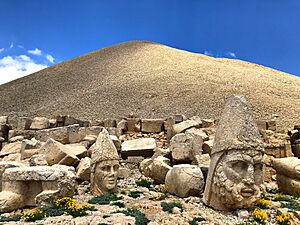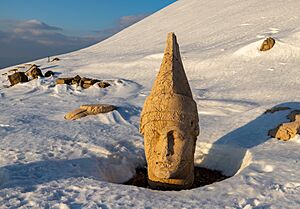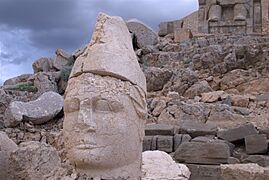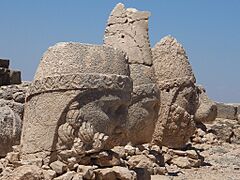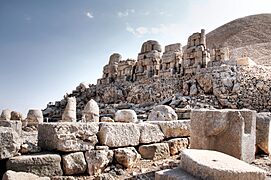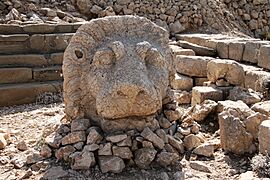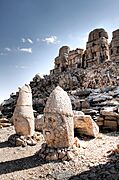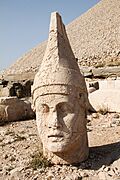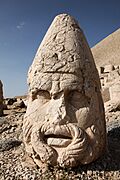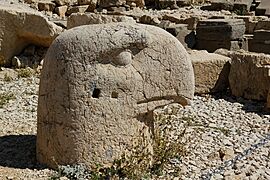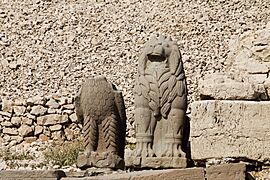Mount Nemrut facts for kids
Quick facts for kids Mount Nemrut |
|
|---|---|
 |
|
| Highest point | |
| Elevation | 2,134 m (7,001 ft) |
| Geography | |
| UNESCO World Heritage Site | |
| Official name | Nemrut Dağ |
| Criteria | Cultural: i, iii, iv |
| Inscription | 1987 (11th Session) |
| Area | 11 ha |
Mount Nemrut, also called Nemrud, is a tall mountain in southeastern Turkey. It stands about 2,134 meters (7,001 feet) high. The mountain is famous for its summit, where you can find many huge statues. These statues are believed to be part of a royal tomb from the 1st century BC. Mount Nemrut is one of the highest peaks in the eastern Taurus Mountains.
Because of its unique historical importance, Mount Nemrut was named a UNESCO World Heritage Site in 1987. This means it is a special place protected for everyone to enjoy and learn from.
Contents
Discovering Mount Nemrut's Secrets
Mount Nemrut is located about 40 kilometers (25 miles) north of Kahta, near Adıyaman. Around 62 BC, a king named Antiochus I of Commagene built a special tomb and sanctuary on top of this mountain.
The Giant Statues
The site features huge statues, each about 8 to 9 meters (26 to 30 feet) tall. These statues represent:
Some of these gods were a mix of different cultures, like Heracles-Artagnes-Ares and Zeus-Oromasdes. King Antiochus combined traditions from Parthia and Armenia to create this unique religious site. The names of the gods were carved onto the statues.
Over time, the heads of these giant statues broke off from their bodies. You can now see them scattered around the site. The way the heads are damaged, especially their noses, suggests that people might have purposely broken them. This act is called iconoclasm, which means destroying religious images. The statues have not been put back together.
Stone Slabs and Ancestors
The site also has stone slabs with carved figures. These carvings are called bas-reliefs and are thought to have been part of a large wall decoration. These slabs, also known as stelae, show King Antiochus's Greek and Persian ancestors.
You can find similar statues and ancestor carvings on a large mound at the site. This mound, called a tumulus, is 49 meters (161 feet) tall and 152 meters (499 feet) wide. It's made of loose rocks. Experts think this mound of rocks was built to protect the tomb from robbers. If anyone tried to dig into it, the loose rocks would quickly fill the hole. The statues have Greek-style faces but wear Persian clothes and hairstyles, showing the mix of cultures.
The Lion Horoscope
On the western side of the mountain, there is a large stone slab with a lion carved into it. This lion carving shows an arrangement of stars and the planets Jupiter, Mercury, and Mars. This arrangement is believed to show the sky on July 7, 62 BCE. This date might be when the construction of this amazing monument began.
The eastern part of the site is very well preserved. It has several layers of rock. A path around the base of the mountain shows there was once a walled walkway connecting the eastern and western parts. People think this site was used for religious ceremonies because of its astronomical and religious features.
The way these statues are arranged is called a hierothesion. Similar arrangements have been found at Arsameia on Nymphaios, which was the hierothesion of Antiochus's father, Mithridates I Callinicus.
Ancient History of the Site
The religious sanctuary on Mount Nemrut was part of King Antiochus's plan to bring back the Persian traditions of his kingdom, Commagene. To do this, he combined the political and religious customs of Cappadocia, Pontus, and Armenia.
Like the Mithridatic rulers of Pontus, Antiochus emphasized that he was a descendant of the Achaemenids and Seleucids. He also claimed to be a royal heir of Armenia. A key part of this identity was the new Greco-Iranian group of gods, which were worshipped at special sanctuaries in Commagene.
Modern Discoveries
The Mount Nemrut site was first explored in 1881 by Karl Sester. He was a German engineer who was looking at transport routes for the Ottoman Empire. Later, in 1947, a woman named Theresa Goell visited the site. She then spent her life studying Mount Nemrut, starting major research projects in 1954.
Even with all the digging and research, King Antiochus's tomb has not been found yet. However, experts still believe he is buried somewhere at this site. The statues, which all have their heads removed, have not been put back to their original positions.
Mount Nemrut: A World Heritage Site
In 1987, UNESCO declared Mount Nemrut a World Heritage Site. This means it's a very important cultural place that needs to be protected for future generations.
Tourists usually visit Mount Nemrut between April and October. The nearby town of Adıyaman is a popular starting point for trips to the site by car or bus. You can also travel there by helicopter. Some tours even run overnight from Malatya or Kahta.
UNESCO describes the site as:
The mausoleum of Antiochus I (69–34 B.C.), who reigned over Commagene, a kingdom founded north of Syria and the Euphrates after the breakup of Alexander's empire, is one of the most ambitious constructions of the Hellenistic period. The syncretism of its pantheon, and the lineage of its kings, which can be traced back through two sets of legends, Greek and Persian, is evidence of the dual origin of this kingdom's culture.
This means the tomb of King Antiochus I is one of the most impressive buildings from the Hellenistic period (a time after Alexander the Great). The mix of Greek and Persian gods and the king's family history show how two different cultures came together in this kingdom.
Gallery
See also
- Cities of the ancient Near East
- List of megalithic sites
- List of colossal sculptures in situ
- Queen of the Mountain — 2005 documentary about the excavation of Mount Nemrut



